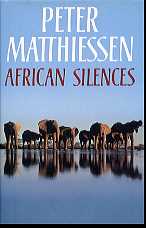
African Silences
Matthiessen, Peter
1991
- Publisher: Random House New York
- ISBN: 0 00 271186 9
- Our classification: Travel writing
- Found: *
- More incredible writing, this time travelling through Central and West Africa in 1987
Book ID 170

Book ID 170
See also
Matthiessen, Peter African Silences, 1991
Page Number: 217
Extract Date: 1987
The Serengeti Plain is a hundred miles across. Flying low over its western reaches, the plane dodges the vultures that attend the endless herds of wildebeest and zebra that scatter away across green grass below. Hyenas in a ditch, a lone male lion. Thousands of wildebeest are streaming across the plain south of the high rock island known as Simba Kopje, near the long road that comes into the park from Ngorongoro and Olduvai Gorge. Nowhere on the Serengeti, in this high tourist season between rains, do we see dust raised by a vehicle, not even one. More ominous still on a hundred-mile west-east traverse of the whole park, not one elephant is seen where years ago I saw five hundred in a single herd. "Poachers," Jonah said. "The Serengeti elephants are down seventy-five percent. What's left of them are mostly in the north, toward the Masai Mara."
He travelled in 1961 and 1969 and stayed in and around the Serengeti, the Crater Highlands, and the Arusha National Park, writing the classic book "The Tree Where Man was Born"
Matthiessen, Peter African Silences, 1991
Page Number: 218
Extract Date: 1987
In 1961, the Serengeti was my ultimate destination in East Africa; in the winter of 1969 it was my home. We land and refuel at Barafu Kopjes, a beautiful garden of huge pale granite boulders and dry trees, in the clear light, where years ago I accompanied George Schaller on long walks across the plain to learn how primitive humans might have fared in scavenging young, dead, or dying animals. The wind is strong in the black thorn of the acacia, and a band of kestrels, migrated from Europe, fill their rufous wings with sun as they lift from the bare limbs and hold like heralds against the wind on the fierce blue sky.
Then we are aloft again, on a course Northeast toward the Gol Mountains, in a dry country of giraffes and gazelles. Olduvai is a pale scar down to the south, in the shadow of the clouds of the Crater Highlands, and soon the sacred volcano called Ol Doinyo Lengai rises ahead, and in the deep hollow in the land that is Lake Natron, on the Kenya border. We will fly across Natron and the Athi Plain and be in Nairobi in an hour.
He travelled in 1961 and 1969 and stayed in and around the Serengeti, the Crater Highlands, and the Arusha National Park, writing the classic book "The Tree Where Man was Born"
